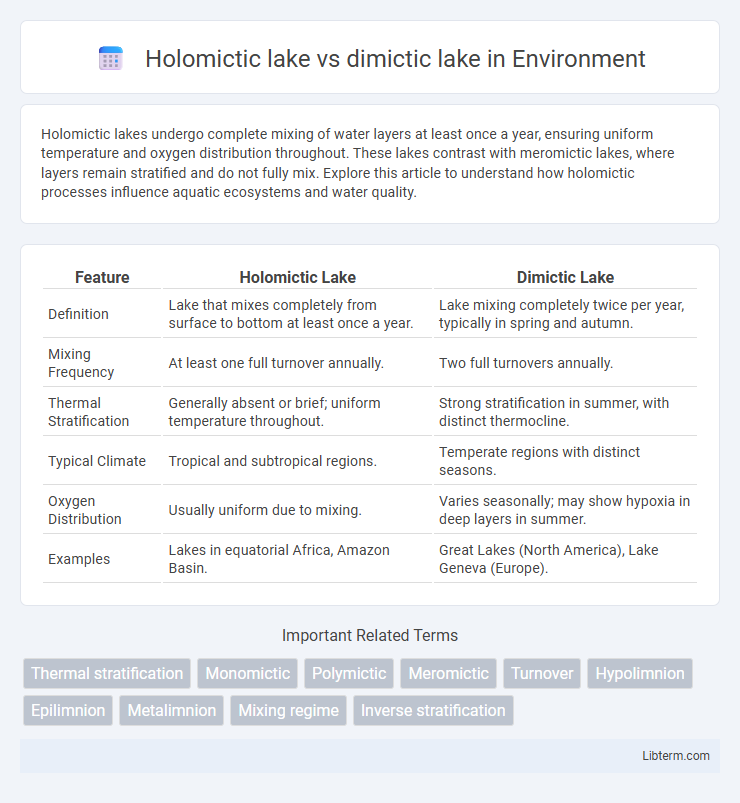Holomictic lakes undergo complete mixing of water layers at least once a year, ensuring uniform temperature and oxygen distribution throughout. These lakes contrast with meromictic lakes, where layers remain stratified and do not fully mix. Explore this article to understand how holomictic processes influence aquatic ecosystems and water quality.
Table of Comparison
| Feature | Holomictic Lake | Dimictic Lake |
|---|---|---|
| Definition | Lake that mixes completely from surface to bottom at least once a year. | Lake mixing completely twice per year, typically in spring and autumn. |
| Mixing Frequency | At least one full turnover annually. | Two full turnovers annually. |
| Thermal Stratification | Generally absent or brief; uniform temperature throughout. | Strong stratification in summer, with distinct thermocline. |
| Typical Climate | Tropical and subtropical regions. | Temperate regions with distinct seasons. |
| Oxygen Distribution | Usually uniform due to mixing. | Varies seasonally; may show hypoxia in deep layers in summer. |
| Examples | Lakes in equatorial Africa, Amazon Basin. | Great Lakes (North America), Lake Geneva (Europe). |
Introduction to Holomictic and Dimictic Lakes
Holomictic lakes experience complete mixing of their water column at least once per year, promoting uniform temperature and oxygen distribution throughout. Dimictic lakes undergo two mixing periods annually, typically in spring and autumn, separated by thermal stratification during summer and ice cover in winter. These mixing patterns critically influence aquatic ecosystems, nutrient cycling, and water quality dynamics in freshwater environments.
Defining Holomictic Lakes
Holomictic lakes are freshwater bodies where the water column undergoes complete mixing at least once a year, ensuring uniform temperature and oxygen levels throughout. Unlike dimictic lakes, which mix twice annually during spring and fall, holomictic lakes can mix once or multiple times depending on their thermal structure and climatic conditions. This mixing plays a crucial role in nutrient cycling and maintaining ecological balance within the lake ecosystem.
Defining Dimictic Lakes
Dimictic lakes undergo two complete mixing periods annually, typically in spring and autumn, driven by temperature changes that regulate water density. These lakes stratify during summer, forming distinct thermal layers, and freeze over in winter, limiting circulation. This cyclical mixing enhances oxygen distribution and nutrient cycling, supporting diverse aquatic ecosystems.
Mixing Patterns in Holomictic Lakes
Holomictic lakes experience complete mixing of their water column from top to bottom at least once per year, driven primarily by seasonal temperature changes and wind action, which prevents stratification. This mixing pattern ensures uniform temperature and oxygen distribution throughout the lake, supporting diverse aquatic life and nutrient cycling. Contrarily, dimictic lakes undergo two mixing periods annually, during spring and autumn, with stratification occurring in summer and winter.
Seasonal Mixing in Dimictic Lakes
Dimictic lakes experience two mixing periods annually, typically during spring and autumn, when water temperature becomes uniform from surface to bottom, allowing oxygen and nutrients to circulate throughout the lake. This seasonal mixing contrasts with holomictic lakes that mix completely at least once a year but vary in frequency depending on climate conditions. The stratification and turnover cycles in dimictic lakes greatly influence aquatic ecosystems, impacting biological productivity and chemical distribution.
Key Differences: Holomictic vs Dimictic Lakes
Holomictic lakes experience complete water column mixing at least once per year, while dimictic lakes mix twice annually, typically during spring and fall. Temperature stratification in holomictic lakes is generally less stable, leading to uniform oxygen distribution, whereas dimictic lakes have distinct thermal layers with anoxic bottom waters during summer. These differences influence nutrient cycling, aquatic life habitats, and lake management strategies.
Ecological Impacts of Lake Mixing Types
Holomictic lakes undergo complete mixing of their water column at least once per year, promoting uniform oxygen distribution and nutrient cycling that supports diverse aquatic ecosystems. Dimictic lakes mix twice annually, typically in spring and autumn, creating distinct thermal stratification periods that can lead to oxygen depletion in deeper layers, affecting fish habitats and nutrient availability. These differing mixing regimes significantly influence primary productivity, biogeochemical processes, and overall biodiversity within lake environments.
Examples of Holomictic and Dimictic Lakes
Lake Superior and Lake Ontario serve as prime examples of dimictic lakes, experiencing two thermal turnovers annually in spring and autumn. In contrast, Lake Tanganyika exemplifies a holomictic lake with continuous mixing of its waters due to consistent temperature gradients. These thermal mixing patterns influence the nutrient distribution and aquatic ecosystems of both lake types.
Importance of Lake Mixing for Aquatic Life
Lake mixing in holomictic lakes, where the entire water column undergoes seasonal overturn, is crucial for redistributing oxygen and nutrients throughout the aquatic ecosystem, supporting diverse and healthy aquatic life. Dimictic lakes, mixing twice yearly during spring and fall, facilitate critical oxygenation of deeper waters and nutrient cycling, preventing stratification-related hypoxia that can threaten fish and invertebrates. Effective mixing regimes promote balanced temperature profiles and nutrient availability, sustaining primary productivity and maintaining overall aquatic biodiversity.
Conclusion: Significance of Understanding Lake Mixing Types
Understanding holomictic and dimictic lake mixing types is crucial for managing aquatic ecosystems, as these patterns directly affect oxygen distribution and nutrient cycling. Holomictic lakes mix completely at least once a year, promoting uniform temperature and oxygen levels, while dimictic lakes undergo two mixing periods, influencing seasonal biological productivity and habitat stability. Effective lake management and conservation strategies depend on recognizing these mixing behaviors to support biodiversity and water quality.
Holomictic lake Infographic

 libterm.com
libterm.com